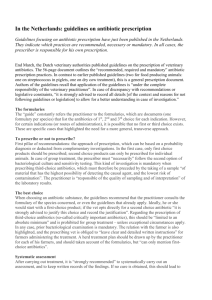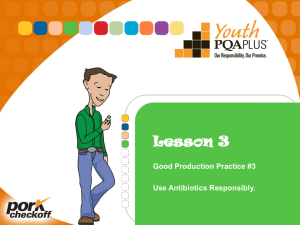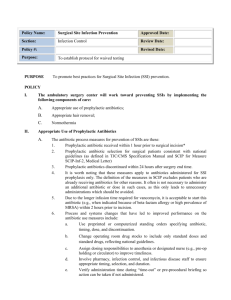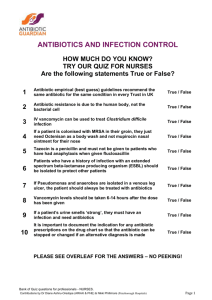Cevolution 2015T3_06_Good antibiotic practices for practitioners in
advertisement
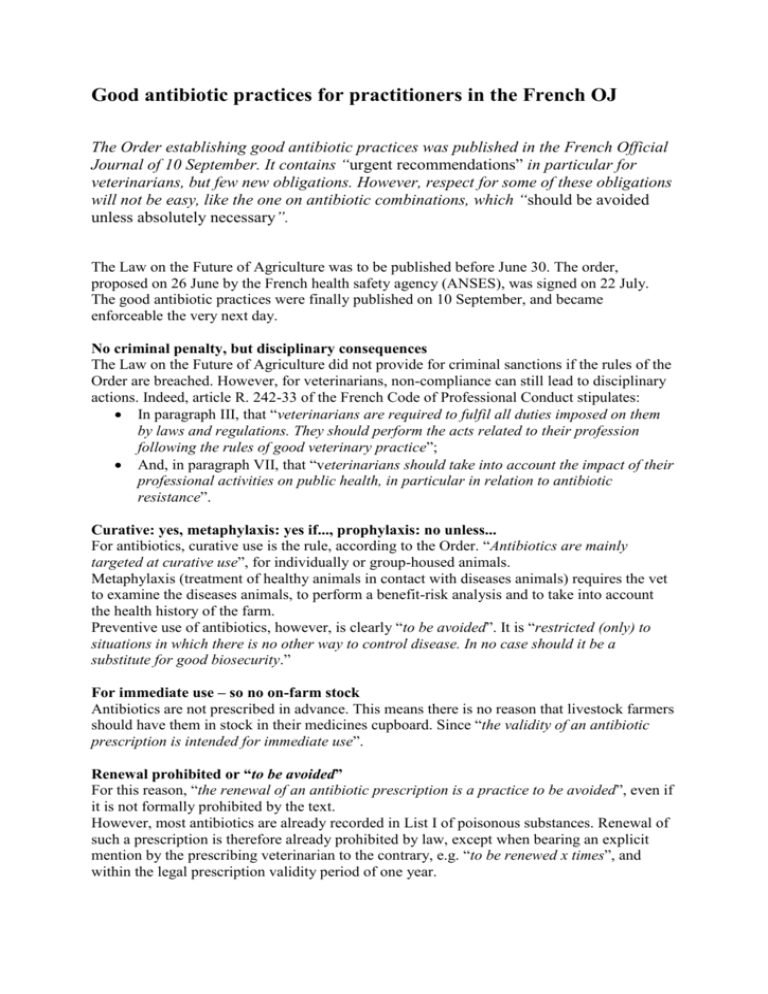
Good antibiotic practices for practitioners in the French OJ The Order establishing good antibiotic practices was published in the French Official Journal of 10 September. It contains “urgent recommendations” in particular for veterinarians, but few new obligations. However, respect for some of these obligations will not be easy, like the one on antibiotic combinations, which “should be avoided unless absolutely necessary”. The Law on the Future of Agriculture was to be published before June 30. The order, proposed on 26 June by the French health safety agency (ANSES), was signed on 22 July. The good antibiotic practices were finally published on 10 September, and became enforceable the very next day. No criminal penalty, but disciplinary consequences The Law on the Future of Agriculture did not provide for criminal sanctions if the rules of the Order are breached. However, for veterinarians, non-compliance can still lead to disciplinary actions. Indeed, article R. 242-33 of the French Code of Professional Conduct stipulates: In paragraph III, that “veterinarians are required to fulfil all duties imposed on them by laws and regulations. They should perform the acts related to their profession following the rules of good veterinary practice”; And, in paragraph VII, that “veterinarians should take into account the impact of their professional activities on public health, in particular in relation to antibiotic resistance”. Curative: yes, metaphylaxis: yes if..., prophylaxis: no unless... For antibiotics, curative use is the rule, according to the Order. “Antibiotics are mainly targeted at curative use”, for individually or group-housed animals. Metaphylaxis (treatment of healthy animals in contact with diseases animals) requires the vet to examine the diseases animals, to perform a benefit-risk analysis and to take into account the health history of the farm. Preventive use of antibiotics, however, is clearly “to be avoided”. It is “restricted (only) to situations in which there is no other way to control disease. In no case should it be a substitute for good biosecurity.” For immediate use – so no on-farm stock Antibiotics are not prescribed in advance. This means there is no reason that livestock farmers should have them in stock in their medicines cupboard. Since “the validity of an antibiotic prescription is intended for immediate use”. Renewal prohibited or “to be avoided” For this reason, “the renewal of an antibiotic prescription is a practice to be avoided”, even if it is not formally prohibited by the text. However, most antibiotics are already recorded in List I of poisonous substances. Renewal of such a prescription is therefore already prohibited by law, except when bearing an explicit mention by the prescribing veterinarian to the contrary, e.g. “to be renewed x times”, and within the legal prescription validity period of one year. For over-the-counter sales, one vet only… In food-producing animals, the text does not prohibit over-the-counter antibiotic prescription (without clinical examination). This remains a fairly common practice for the sales of some classes of antibiotics such as intramammary tubes. In these cases, the Order recommends that farmers use one and the same veterinarian (so a single practice) for the herd health scheme and the protocol of care, allowing the veterinarian to prescribe and dispense without clinical examination. Alternatively, if several vets carry out herd health schemes and draw up protocols of care, all the different documents should be “brought to the attention of the different veterinary practitioners”. The aim is to avoid “a proliferation of antibiotic prescriptions by different vets” in case the farmer goes around visiting all competing practices in order to obtain the antibiotics he wants. Leftovers: “prescription-only” or even “prohibited” To avoid self-medication, the use of leftover (unexpired) antibiotics requires a new prescription, the Order warns farmers. However, for companion animals, the text is stricter. The re-use of leftover antibiotics is “strictly forbidden”, as is self-medication with human antibiotics. The owner “should ensure that no leftover antibiotics remain in stock at his home, in order to avoid future use”. Bacteriology: “as often and as early as possible” Bacterial culture and sensitivity testing will not become compulsory. However, the tests are strongly recommended for any antibiotic treatment, not just for critical antibiotics. “Bacterial culture and sensitivity testing should be performed as often as possible and as early as possible, in untreated animals”. “Analyses should be performed in veterinary diagnostic laboratories” (not in human ones). Their results should take into consideration interpretation criteria that have been validated for veterinary medicine for the classification of R (resistant), I (intermediate) and S (susceptible). They only mention substances that are authorised for veterinary use (excluding antibiotics restricted to human medicine). Sensitivity testing is only one of ten selection criteria for an antibiotic, for which the number one criterion is “the experience and the knowledge of the veterinarian”. However, in case of treatment failure or relapse, microbiological tests are almost mandatory prior to the prescription of a second-line treatment. De-escalation after the emergency “In emergency situations or if sampling is not feasible, antibiotic treatment can be prescribed, possibly pending results”. Once these are obtained, antibiotic treatment is then adjusted for ‘de-escalation’ purposes if possible. As soon as the microbiological results are known, de-escalation consists of returning to narrow-spectrum, first intention antibiotics, rather than continuing the use of large-spectrum critical antibiotics prescribed in severe emergency cases. This is because the selection pressure for resistance is correlated to the duration of treatment. Antibiotic combinations: avoid “unless absolutely necessary” “The use of antibiotic combinations is not recommended. In case of absolute necessity, it may be considered and justified.” The Order does not specify if the “non recommended” combinations are targeted at all combinations, including common old antibiotic combinations, whether injectable (e.g. penicillin/streptomycin, ampicillin/colistin), topical or intramammary; or only the combinations of several substances on the same prescription, like to association of an injectable antibiotic with an intramammary one; or of a fluoroquinolone with a betalactam. Common sense probably dictates that the synergetic combination trimethoprim-sulfa is not targeted by this provision. Furthermore, combinations aimed at broadening the spectrum are the main targets of the new legislation. Since, although very often an additional antibiotic does not add anything in terms of activity, it increases the selection pressure for resistance, or even multi-resistance. Critical antibiotics: waiting for an Order “The use of critical antibiotics should be in compliance with the legislation in force”, alluding to a Decree which has still not been published. However, the proposals were widely circulated and discussed late 2014. The clinical examination and antibiotic sensitivity testing – whenever feasible – should become mandatory for at least fluoroquinolones and last generation cephalosporins (3GC/4GC). Off-label may be justified by… EBM According to this Order, “ the veterinarian ensures that, besides his knowledge and experience, his prescription is based on data obtained in agreement with evidence-based medicine (EBM)”. No surprisingly, veterinarians prefer the marketing authorisations or rather the SPC (summary of product characteristics) for the species, indications and dosage. If he decides not to follow these, the decision should be justified. SNGTV Factsheets In case the dosage is modified, the Order recommends the prescriber to rely on fact sheet recommendations per species and per disease issued by professional organisations, the SNGTV (French farm animal veterinary society) for food-producing animals. Refrigerated cabinets fitted with an alarm Both veterinarians and pharmacists should be equipped for the storage of antibiotics with “refrigerated cabinets fitted with a temperature monitoring system and an alarm”. Even though the very large majority of antibiotics are not heat-sensitive (with some notable exceptions such as injectable “pen-strep”). Source: Order of 22 July 2015 on the good practices of the use of medicines containing one or more antibiotic substances, in veterinary medicine (OJ 10/9/15, in French). http://www.legifrance.gouv.fr/affichTexte.do?cidTexte=JORFTEXT000031142007&dateTexte =&categorieLien=id


